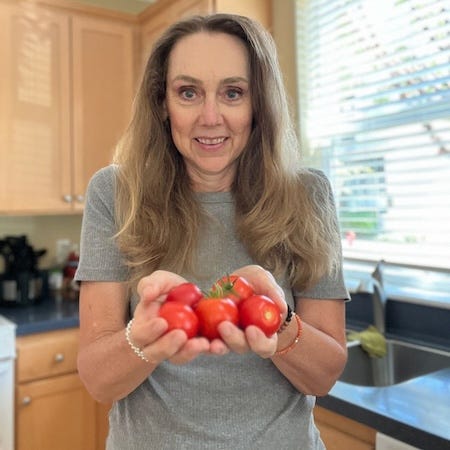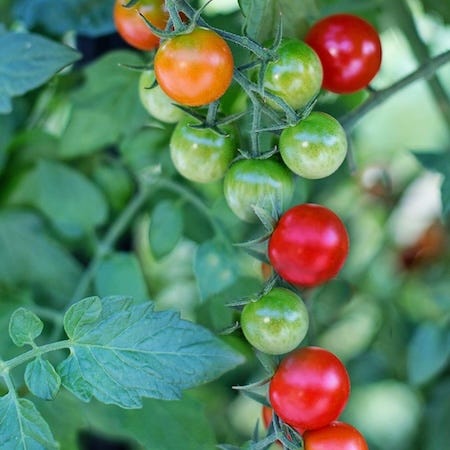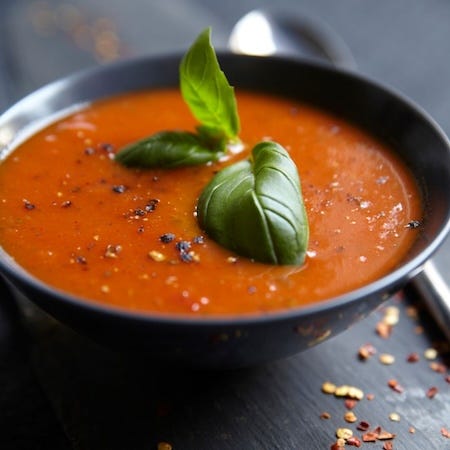A Tutorial on Tomatoes - Grow ‘em, Pick ‘em, Freeze ‘em, Use ‘em
I get into the nitty-gritty of this Gorgeous fruit we can’t live without
Welcome to Roots! A newsletter about plant-based: eating, nutrition, lifestyle, I cover it all. Join me, Lori Osterberg, as I explore good food, great health, and Gorgeous Wellth! New here? Get started.
When I think about the turning points in my plant-based journey, I always come back to tomatoes. After losing my father when he was just 54, I became acutely aware of how our food choices impact our health. But awareness doesn't always translate to sustainable change—it was growing my first successful tomato harvest that truly transformed my relationship with food.
I still remember that first summer. I had planted three varieties, mostly hoping that something would survive my novice gardening skills. By August, I was overwhelmed with tomatoes—sweet cherries, meaty Romas, and juicy beefsteaks. Standing in my garden, tomato juice running down my arm as I bit into one still warm from the sun, I had an epiphany: this is what food is supposed to taste like.
That connection—the direct line from soil to table—made plant-based eating feel less like a restriction and more like an abundance. I wasn't giving up anything; I was gaining a world of flavor I had been missing. Now, my tomato garden has expanded every year, and it symbolizes everything I value about clean, nourishing food that supports our bodies through every stage of life.
Jumping into my garden this year with tomatoes 🍅
What does a person do when they get home from vacation? Yes, there are loads of laundry. The house needs a good cleaning too.
But in my world, returning home from vacation in March means it’s time to start thinking about my garden.
Last September, as I made my way through my local farmer’s market, I stopped at a booth overflowing with tomatoes. I shop there every year, and pick up heirloom tomatoes I don’t grow in my own garden.
But last year, I noticed a little box on the side filled with seeds. When I asked about them, the owner told me they sell heirloom seeds for all the tomatoes they offer inside her booth. I was mesmerized.
And, of course, I bought. Six little packets of seeds for heirloom tomatoes I’ve never grown before.
I pulled them out of their envelope this weekend and popped a few of the seeds into growing containers. I set them up with grow lights, and I’m watering them every day. Voila! My 2025 garden has officially begun.
Is it a fruit? Is it a vegetable?
I always laugh whenever I hear this question come up. Because the answer is so … American.
The reason tomatoes are considered vegetables in the US instead of fruits comes down to a Supreme Court case, Nix vs Hedden, 1893. John Nix argued that tomatoes should be exempt from tariffs as they were fruits, not vegetables. However, the Supreme Court disagreed. Because tomatoes are typically used in savory dishes, and thought of as veggies in the general public, they should be taxed as vegetables.
No matter how you classify them, tomatoes are the workhorses of the garden. Whenever I talk with people about gardening, tomatoes are the go-to thing to plant.
That’s because they are one of the hardiest plants you can plant. Put it in a pot. Stick it with flowers in a hanging basket. Throw it in a garden plot. Water it, and the plant will thrive.
Tomato power: A midlife health ally
While the classification debate is amusing, what's undeniable is the incredible health benefits packed into these juicy gems. For us women navigating midlife, tomatoes are particularly valuable allies. (Yes, I’m unleashing the nutritionist in me here for a minute or two.)
Tomatoes contain lycopene, a powerful antioxidant that gives them their red color. Studies have shown lycopene may help reduce heart disease risk—something increasingly important as we age. Interestingly, the lycopene in tomatoes becomes more bioavailable when cooked, so your frozen tomatoes used in soups and sauces might actually be more beneficial than raw ones!
They're also rich in vitamins C and K, potassium, and folate. The vitamin C supports collagen production (hello, skin health!), while potassium helps maintain healthy blood pressure. And with only about 35 calories per medium tomato, they're a nutrient-dense addition to any meal.
For those of us concerned about bone health, research suggests the antioxidants in tomatoes may help reduce oxidative stress that contributes to osteoporosis. It's another reason to embrace these versatile plants in our gardens and kitchens.
The plant-based lifestyle connection
When I talk with clients about transitioning to a plant-based lifestyle, one of the biggest hurdles they mention is finding fresh, flavorful produce that makes plant-centered meals exciting. Growing your own tomatoes is one of the simplest yet most powerful steps you can take toward a sustainable plant-based life.
There's something transformative about plucking a sun-warmed tomato from your own garden. That direct connection to your food—watching it grow, caring for it, harvesting it at peak ripeness—changes your relationship with what you eat. My clients often tell me that once they grow their first tomatoes, they become more invested in other aspects of plant-based eating too.
Plus, growing even a portion of your own food reduces your reliance on the conventional food system that often prioritizes shelf life over nutrition. When you bite into a homegrown tomato bursting with flavor, those bland supermarket versions simply won't satisfy anymore. It's a beautiful gateway into appreciating the true taste of plants—a cornerstone of maintaining a plant-based lifestyle for the long term.
Let’s start with growing tips
I remember the first tomato plant I grew. I placed it in a pot on my patio, put a tomato cage around it, and let it grow. Yes, I got a few tomatoes that year. But I’ve learned sooo much more.
Like, you can grow tomato plants anywhere! Yes, they need sunshine. But if you're short on space, this is a win/win.
I LOVE hanging baskets. I fill them with all kinds of flowers. After attending an online gardening masterclass, I discovered it’s even more fun to mix veggies and flowers. Those little cherry tomatoes create gorgeous hanging vines. So you can put tomatoes (and herbs, I love adding mint) to hang down, and put lots of pretty flowers to grow up. (I put them into vases of flowers around my house too.)
Of course, if you have plenty of room, you can plant tomatoes in a pot and use the more traditional tomato cage. Have even more room? Place them in the ground to expand your growing opportunity.
Just be sure you prune tomato suckers early in the growing season. These are the little side shoots that emerge from where the leaves join the main stem. You can find all kinds of videos online on how to do this well.
I’m also experimenting with training tomato plants to grow up on string leaders, again, to maximize production. Instead of trapping tomatoes in a cage, they will follow the lead up, thus producing a ton of tomatoes that are easy to pick. You should have a vining variety to make this work well.
You know tomatoes are ready to pick when …
The best part of growing tomatoes yourself is the flavor. Supermarkets pick them early, meaning they don’t ripen on the vine, and thus, lose their flavor. But when you’re growing, you choose when to pick. (And trust me, the flavor intensifies when you wait til they ripen.)
Not every tomato is red. Some turn yellow. I have a dark purple/black variety this year I’m excited to try. Some are variegated with lots of color throughout. This is your starting point. What color should a fully ripened tomato be? Then, wait for them to be full-color, deep shades, depending on what variety you’re growing.
The skin will be shiny, glossy. They should feel tender and supple. And when you twist it to take it off the vine, it should almost fall off in your hands. And the best part is the smell. You’ll notice that familiar tomato fragrance when you hold it in your hand.
Freeze em …
Here’s something you might not know. (I didn’t until last year.) You can freeze tomatoes!
I never considered freezing tomatoes until I read about it in a gardening book.
We had so many tomatoes last year, and we didn’t want to give them all away. So we looked for options, and freezing actually works. (This isn’t tomato sauce - the actual tomatoes.)
Here’s what we did. Take ripe tomatoes and score an X at the top. Then place them in a freezer bag and layer them in your freezer.
When you take them out, place your tomatoes on a plate. As they thaw, the skin will separate, and you can easily remove it, ready for cooking. I LOVE mixing them in stews, chilis, and soups. You can make sauces that highlight the gorgeous flavors of what you grew. It’s truly Gorgeous!
Use em …
Do you have lots of ideas? I hope so. And I hope you’re as excited as I am about getting the most out of your tomatoes this year.
Yes, frozen tomatoes are more viable for use in entrees like soups and sauces. They will fall apart as they thaw. But mmm … Sometimes that’s the best way.
Like a simple tomato basil soup. It’s one of my favorites.
Tomato Basil Soup
2 ½ pounds tomatoes
1 medium yellow onion
4 garlic cloves
3 tablespoons olive oil
Salt and pepper
3 cups veggie broth
1 tablespoon balsamic vinegar
1 cup packed fresh basil leaves
⅓ cup nutritional yeast
Salt and pepper
Preheat the oven to 350°F. Line a large baking sheet with parchment paper or silicone mat. Cut tomatoes in half or quarters, depending on the size, and place cut side up on the baking sheet. Cut onion in quarters and scatter on the baking sheet between the tomatoes. Slice the garlic cloves and scatter on a baking sheet. Sprinkle with olive oil and salt and pepper. Bake for 45 minutes or until the edges brown and just start to shrivel.
Transfer tomato mixture to a soup pot. Add in veggie broth, vinegar, basil leaves, and nutritional yeast. Stir to combine, and simmer for a few minutes until basil leaves wilt.
Use an immersion blender to blend until smooth. Alternatively, cool slightly and pour into a blender, working in batches if necessary. Blend until smooth.
Season to taste. Ladle into bowls, and enjoy.
p.s. Did you like this message? It would mean a lot to me if you’d press the ❤️ below if you liked it, left a comment 💬, or shared it with a friend. I’m trying to grow this publication, and I depend on people like you to do so!
And if you’re new here, Welcome! 💐 I’d love to start sharing my message with you if you’re interested in all things plant-powered, proaging, or finding kitchen joy. Subscribe … and then explore my entire archive! Glad to share with you! 🙋🏼♀️









